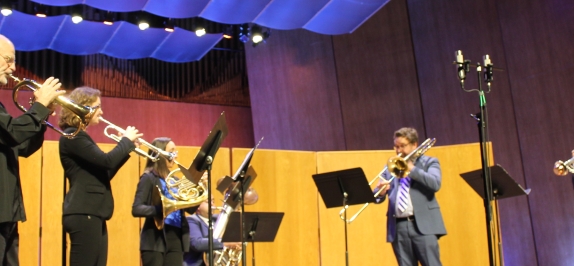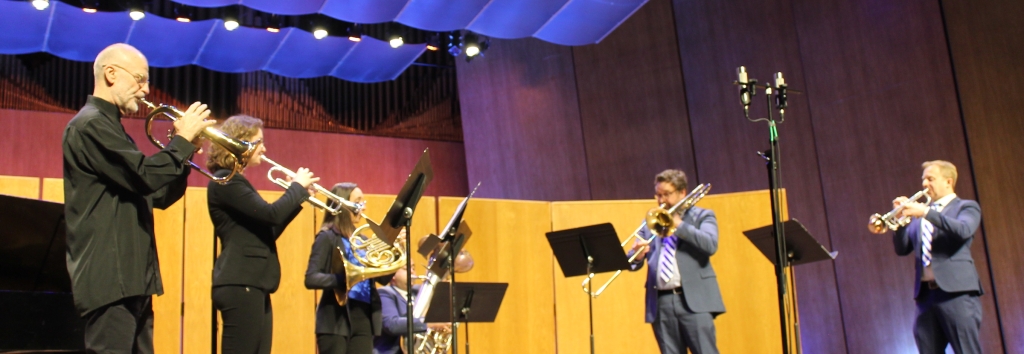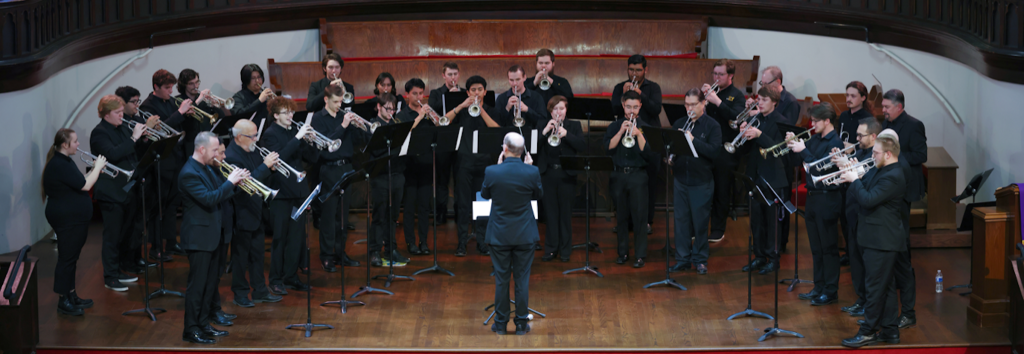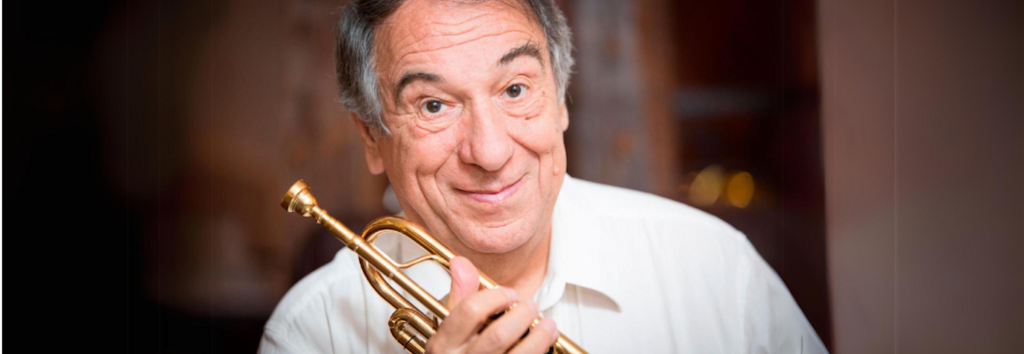
JOIN ITG
Memberships include:
- Four 100+ page ITG Journals
- Unrestricted site access
- Access to members only content
- Annual premium CD or DVD
- Exclusive discounts
- Free extras (music, booklets, etc.)
UPCOMING EVENTS


Sokratis Anthis at the University of Kentucky
Greek trumpeter Sokratis Anthis was a guest artist at the University of Kentucky (UK) March 18–21, 2024.
MORE
Ellsworth Smith International Solo Trumpet Competition Deadline Extension
The International Trumpet Guild is pleased to announce an extension for the 2024 Ellsworth Smith Solo Trumpet Competition. The deadline for registration is now May 15, 2024. Any questions may be directed to [email protected].
MOREMiller: Two rediscovered Trumpet Sonatas by Mario Castelnuovo-Tedesco
Additional Materials
Citation
Miller, Danny. "Two rediscovered Trumpet Sonatas by Mario Castelnuovo-Tedesco." Lecture presented virtually at the International Trumpet Guild Conference, Minneapolis, MN, May 31, 2023.Abstract
The 1950s witnessed a wealth of new trumpet compositions unrivaled since the Italian Baroque era, mostly consisting of works for trumpet and piano. By our modern day most of the composers’ names are familiar to us, including Kent Kennan, George Antheil, Halsey Stevens, Bernard Tuthill. By no means is this repertoire merely limited to American composers, as compositions by Otto Ketting, Yuri Chichkov, and Karl Otto Runolfsson will attest. The rediscovery and publishing of two sonatas by Mario Castelnuovo-Tedesco adds two more significant works that should be considered as the equal of these well-established works. The purpose of my presentation is to introduce these sonatas to a wider audience.
The presentation will commence in two parts: 1. A brief outline of Castelnuovo-Tedesco’s life, and some analysis (with recorded examples) of important features of these two sonatas.
The brief outline of the composers’ life, including his dramatic escape with his family from pre-WW2 Italy and immigration to the United States will open the presentation. Especially important is his contribution to the genre of movie soundtracks in the 1940s and 1950s while working for M-G-M and other studios. As a performer and teacher during this era he would teach and influence such composers as Henry Mancini and John Williams. He eventually wrote two trumpet sonatas for Vladimir Drucker who studied with Willy Brandt before leaving Russia for the United States. Drucker and Castelnuovo-Tedesco likely met in Los Angeles in the 1940s when Drucker was also performing on movie soundtracks. This historical outline is well attested in several works by Edward Tarr and Library of Congress material.
For reasons that will be explored, the two sonatas in question have been more-or-less forgotten. I have found precious few references to them at all and even fewer mentions of performances of the same. They are listed in the composers’ Grove article and listed (as his opp. 179/1 and 179/2) in his works list in the Library of Congress, but until now only existed in manuscript form.
In 2017 Edizioni Curci of Italy republished these two wonderful sonatas in an excellent new edition. I had my own small part to play, as I contacted the composers’ granddaughter, and trustee of his unpublished materials and helped stimulate the swift publication of the sonatas.
My presentation will contain brief discussion of several salient features of the two sonatas, in an effort to convince an audience why these two pieces should re-enter the repertoire. They are well-written, fun, challenging, and important pieces written by a major composer (one who taught Henry Mancini and John Williams) and I look forward to their future performances and recordings. The sonatas are excellent additions to the trumpet repertoire and I have no doubt they will become beloved by fellow trumpeters if they are made aware of their existence.
Return to Research Room
Bridging the Gap: The Earliest Trumpet Methods & Their Influences in Modern Trumpet Pedagogy
Additional Materials
- Complete Article in the ITG Journal, January 2023, p. 47.
Citation
Dueppen, Matthew. "Bridging the Gap: The Earliest Trumpet Methods & Their Influences in Modern Trumpet Pedagogy." Lecture presented virtually at the International Trumpet Guild Conference, Minneapolis, MN, May 31, 2023.Abstract
The earliest trumpet methods were written over four centuries ago, yet many critical pedagogical concepts have remained consistent to the common era. Distinct similarities between the methods of Cesare Bendinelli and Girolamo Fantini appear in the writings of Jean-Baptiste Arban and persist in even the most recent trumpet pedagogy methods. The use of specific articulation syllables, for instance, find their earliest forms in Bendinelli’s method, as does a unique focus on changes in syllables and tongue placement (“ah” to “ee”) to adjust pitch and register. The use of these syllables as the basis for flexibility studies and lip slurs appear in these early methods as well. These early pedagogues may not have realized precisely or scientifically what was occurring within the mouth acoustically, but their descriptions within their writings indicate a keen awareness of the topic and the importance of imparting it to students. This article will explore a few pedagogies of our earliest manuscripts in trumpet pedagogy and draw parallels with our modern trumpet methods as it relates specifically to vowel changes and fluctuations within the oral cavity to produce varied pitches.
Bendinelli’s method remains the first to reference and connect the notion of syllabic uses and changes in oral cavity shape to alter pitch. These concepts are further explored in Fantini’s method and help to connect these early methods with modern trumpet pedagogy. Most modern trumpet methods focus on the syllables “ah (aw)” and “ee” to further highlight the change in the tongue level and the oral cavity while teaching lips slurs and flexibility on the trumpet. Allen Vizzutti’s 2007 annotations to Arban’s trumpet method, for instance, use “tah”, “tu”, and “tee” in a way remarkably consistent with Bendinelli’s use of “dan”, “ten”, and “tin.” This directly relates to the change in tongue position in varied registers.
The consistency we see between the early pedagogical writings of Bendinelli and Fantini and modern trumpet pedagogy instruction demonstrates an underlying truth about the nature of mouth shape and tongue placement in playing the instrument. Whether these early pedagogues arrived at their observations independently or through some common influence, both Bendinelli and Fantini clearly understood the importance changing syllables and being conscious and consistent about it, much like the use of these vowel sounds in singing. Modern science and MRI technologies have done much to reveal the exact processes that occur in our mouths as we play brass instruments, but these early musicians arrived at the underlying idea in ways to achieve the desired results intuitively. Further research and study of these earliest trumpet methods can lead to other insights not only about consistency of approach, but also fundamental truths about how we approach the instrument today.
Bibliography
- Bendinelli, Cesare, Edward H. Tarr, and Peter Downey. Tutta Larte Della Trombetta, 1614. Vuarmarens: Bim, 2011.
- Baines, Anthony. Brass Instruments: Their History and Development. New York: Dover Publications, 1993.
- Tarr, Edward. The Trumpet. Portland, Or.: Amadeus Press, 1988.
- Smithers, Don L. The Music and History of the Baroque Trumpet before 1721. Carbondale: Southern Illinois University Press, 1988.
- Fantini, Girolamo, and Edward H. Tarr. Modo per Imparare e Sonare Di Tromba Tanto Di Guerra Quanto Musicalmente: in Organo, Con Tromba Sordina, Col Cimbalo e Con Ognaltro Strumento. Nashville: Brass Press, 1978.
- Altenburg, Johann Ernst. Essay on an Introduction to the Heroic and Musical Trumpeters and Kettledrummers Art: for the Sake of a Wider Acceptance of the Same, Described Historically, Theoretically, and Practically and Illustrated with Examples. Nashville: Brass Press, 1974.
- Eichborn, Hermann Ludwig. The Old Art of Clarino Playing on Trumpets: Translated, with an Introduction and Notes by Bryan R. Simms. Nashville, TN: Brass Press, 1976.
- Johnson, Keith. The Art of Trumpet Playing. Denton, TX: Gore Publishing, 1994.
- Tarr, Edward H. The Trumpet. Chandler, Ariz: Hickman Music Editions, 2008.
- Hickman, David R., and Amanda Pepping. Trumpet Pedagogy: A Compendium of Modern Teaching Techniques. Chandler, AZ: Hickman Music Editions, 2006.
- Farkas, Philip. The Art of French Horn Playing: A Treatise on the Problems and Techniques of French Horn Playing ... Evanston, Il.: Summy-Birchard, distributed by Warner, 1956.
- Anthony, James R. Edition: Rev. and expanded ed. Portland, OR: Amadeus Press. 1997. eBook.
- Cabrini, Michele. Notes. Dec2016, Vol. 73, Issue 2, p334-339.
- Ponsford, David. Organists' Review. Dec2011, Vol. 97 Issue 4, p4-10.
- Nicholson, Graham. Early Music. May 2010, Vol. 38 Issue 2, p193-202.
- François-Joseph Fétis, Biographie Universelle des Musiciens, Vol. III, (Paris: Firmin Didot Brothers, 1866), 100.
- Proksch, Bryan. “Buhl, Dauverné, Kresser, and the Trumpet in Paris, Ca. 1800-1840”.
- Historic Brass Society Journal, Vol. 20, (2008): 69-91.
- Koehler, Elisa. Fanfares and Finesse: A Performers Guide to Trumpet History and Literature. Bloomington: Indiana University Press, 2014.
- Anzenberger, Friedrich. “Method Books for Valve Trumpet to 1850: An Annotated Bibliography.” Historic Brass Society Journal, Vol. 9, 1997: 50–62.
- Humphries, John. The Early Horn: A Practical Guide. Cambridge: Cambridge University Press, 2000.
- Bloss, Laura. Natural Trumpet Music and the Modern Peformer. University of Akron, Ohio. Dec. 2012
- Locke, Nate. From Bendenelli to Arban: Styles of Articulations within Selected Trumpet Methods. Columbus State University, Georgia. Dec. 2011
- Lewis, Shelby Allen, "Fantini and Frescobaldi in Rome, Circa 1634: A Study of Context and Practice" (2014). LSU Doctoral Dissertations. 3655.
- Fantini, Modo. English transl. by Edward H. Tarr, Method for Learning to Play the Trumpet (Nashville, 1975)
- Roseborrough, Andrew Jay, "The Modern Pedagogical Potential of the Baroque Natural Trumpet" (2010). Open Access Dissertations. 411.
- Shirali, Shailesh A. “General Article: Marin Mersenne, 1588–1648”. Resonance Magazine, March 2013.
- Mace, Dean T. “Marin Mersenne on Language and Music”. Journal of Music Theory, Vol. 14, No. 1, Spring 1970, pp. 2-34.
- Chancellor, Evan G. “Heinrich Domnich: A Discussion of His Career, Pedagogy, and Concert Works for the Horn,” n.d. University of Oklahoma, 2013.
- Conforzi, Igino (trans. Alexandra Amati-Camperi). “Girolamo Fantini, Monarch of the Trumpet: New Light On His Works”. Historical Brass Society, JL 1, Vol. 10, 1993.
- Stoltzfus, Andreas M., and Keith Johnson. “Was There a Trumpet Sonata before the Trumpet Sonata?: An Investigation of Girolamo Fantini’s Trumpet Sonatas with Respect to Other Stile Moderno Solo Instrumental Sonatas,” n.d. University of North Texas, 2015.
- Shamu, Geoffrey. “Merri Franquin and His Contribution to the Art of Trumpet Playing,” Boston University, 2004.
- Conforzi, Igino (trans. Jesse Rosenberg and Henry Meredith) “Girolamo Fantini, Monarch of the Trumpet: Recent Additions to his Biography”. Historical Brass Society, J.L. 1, Vol. 4, 1994.
- Boylan, Andrew R. “The Trumpet Teachers Handbook: A Comprehensive Musicianship Guide,” n.d. Indiana University, 2018.
- Dauverne, Francois Georges Auguste. “Dauverne Trumpet Method 1857: A Complete Translation.” Historic Brass Society Journal 3 (1991): 179–261. https://doi.org/10.2153/0119910011013.
- Anzenberger, Friedrich. “Method Books for Natural Trumpet in the 19TH Century: An Annotated Bibliography”. Historical Brass Society. Vol 1, No. 1, 1993.
- Anzenberger, Friedrich. “Method Books for Keyed Trumpet in the 19TH Century: An Annotated Bibliography”. Historical Brass Society. Vol 1, No. 1, 1994.
- Lewis, Lucinda. Broken Embouchures: an Embouchure Handbook for Embouchure Dysfunction Caused by Overuse, Injury, Medical and Dental Conditions. United States: Oscars House Press, 2013.
- Hamou, Philippe. “Marin Mersenne.” Stanford Encyclopedia of Philosophy. Stanford University, May 11, 2018. https://plato.stanford.edu/entries/mersenne/.
- Staff, Editorial. “Updated Facsimiles of Bendinelli and Fantini.” Historic Brass Society, December 31, 2012. https://www.historicbrass.org/20-features/music-reviews/191-updated-facsimiles-of-bendinelli-and-fantini.
- Wallace, John, and Alexander McGrattan. The Trumpet. New Haven: Yale University Press, 2012.
- Downey, Peter, "A Renaissance Correspondence Concerning Trumpet Music." Early Music 9.3 (1981): 326, Accessed Dec. 2019, JSTOR.
- South, James. References to Trumpet Music in the Battle Chansons of Clement Janequin. University of North Texas, May 1990.
Return to Research Room
Burt: Charamelas, Royal Shawms and the Music of Portugal’s Court Trumpet and Kettledrum Corps
Additional Materials
- Research Poster
- Conference Handout
- Forward to the Hickman Edition of the Charmalas (2023)
- Research Website: Additional Sound Recordings
- Research Website: Facsimiles Source Documents
Citation
Burt, David. "Charamelas, Royal Shawms and the Music of Portugal’s Court Trumpet and Kettledrum Corps." Lecture presented virtually at the International Trumpet Guild Conference, Minneapolis, MN, May 31, 2023.Abstract
Johann Altenburg’s 1770 manuscript described privileges, protections, and ultimately the decline of royal trumpet and kettledrum guilds. As Altenburg was writing his treatise, Lisbon, Portugal was rebuilding an earthquake-devastated city. Silver trumpets were either built or modified with ornamented garlands dated 1761 (with eventually two more dated 1785) and an entire collection of music of Portugal’s Royal Trumpet and Kettledrum Corps was copied into leather-bound part-books.
Sparse musical examples exist that fully illuminate Altenburg’s description of the majesty and ceremony of court trumpet and kettledrum corps. The surviving part books located in the Museu Nacional dos Coches of Portugal’s Court Trumpet and Kettledrum Corps are an original, musical record of Altenburg’s descriptions, and of royal ceremony provided by court trumpet and kettledrum corps.
As each of the 26 part-books contain all 54 compositions, it is possible to compare 1404 individual parts of the 54 compositions for decisions regarding articulation and dynamic markings. It is also possible to trace evolutions of complexity pertaining to composition, tonalities, and technical demands throughout the 54 compositions. The information revealed by observing personal musical decisions made by trumpeters from the 18th century is unparalleled. No comparable music or collection exists that allows such an in depth and intimate examination of court trumpeters and kettledrummers.
Changes and evolutions that occur throughout the 54 compositions; frequency, types, and manners of dynamics, varieties of articulations, specificity of note lengths, tonalities, and harmonies indicate that the full music collection was amassed over a period of years or decades and preserved in the existing part-books. The part-books are a primary-source working record of the largest royal trumpet and kettledrum corps of the 18th century.
Nearly fifty years have past since the part-books of Portugal’s Court Trumpet and Kettledrum Ensemble were “rediscovered;” only 13 of 54 compositions have been available for study and performance.
The use of the term Charamela Real, Sonatas, and the dating of the music collection are existing postulations that were assigned to Portugal’s Trumpet and Kettledrum Corps and they continue to hinder a full awareness of the music and instrument collection and the importance of this specific trumpet and kettledrum corps.
The music of Portugal’s Trumpet and Kettledrum Corps serves as an aural companion to Altenburg’s treatise even as it demonstrates evolutions of trumpet ensemble music beyond those known to Altenburg in 1770. Trumpet and kettledrum formations in Portugal have a history dating back to 1347. 22 silver natural trumpets with ornamented garlands of 1761 and 1785 still exist today as does the original repertory of Portugal’s Trumpet and Kettledrum Corps. It is time that full recognition and exposure to the remarkable music is afforded to this singular primary source collection that exhibits the grandeur, creativity, and evolution, of court trumpet and kettledrum corps.
Biblography
- Johann Ernst Altenburg, Versuch einer Anleitung zur heroisch-musikalischen Trompeter-und Pauker-Kunst (Halle 1795, facs. rpt.: Leipzig 1972; Eng. trans. By Edward H. Tarr, Nashville, 1974), 29.
- Michel’ Angelo Lambertini, “A Charamela,” A Arte Musical magazine, February 28 cont. March 15, 1913.
- Edward H. Tarr, “Die Musik und die Instrumente der Charamela Real in Lissabon,” Forum Musicoloogicum II: Basler Studien zur Interpretation der alten Musik (Zurich: Amadeus, 1980), 181-229.
- Gerhard Doderer, “A constituição da Banda Real na Corte Joanina (1721-24), Revista Portuguesa de Musicologia, nº 13, 2003, 7.
- Albert Hiller, Music for Trumpets from Three Centuries (c. 1600 – after 1900) Compositions for 1-24 (Natural) Trumpets with and without Timpani, Wolfgang G. Haas-Musikverlag, Postfach, Köln 90, 1993.
Return to Research Room
Apple: A(n) (Un)Missing Link Between Keys and Valves: Three Keyed Trumpet Solo Works Arranged for Early Valved Trumpet, Flügelhorn, and Valved Trombone by Joseph Kail for the Prague Conservatory
Additional Materials
Citation
Apple, Robert Warren. "A(n) (Un)Missing Link Between Keys and Valves: Three Keyed Trumpet Solo Works Arranged for Early Valved Trumpet, Flügelhorn, and Valved Trombone by Joseph Kail for the Prague Conservatory." Lecture presented virtually at the International Trumpet Guild Conference, Minneapolis, MN, May 31, 2023.Abstract
A prevalent misconception regarding the music composed for the keyed trumpet is that it had little influence on that performed on and written for the valved instruments that eventually replaced it. In past conference presentations, however, I pointed out that much of the military band and church music that originally made use of the keyed trumpet was later performed using the early valved trumpet and flügelhorn. This ensured that much of the keyed trumpet’s ensemble repertory continued to be performed long after the instrument fell out of use, which is perhaps unsurprising given the pragmatic nature of many music directors.
What is unexpected, however, is that Joseph Kail—an early proponent and the first conservatory professor of the early valved trumpet—arranged three solo works originally composed for the keyed trumpet for the early valved trumpet, valved trombone, and flügelhorn with piano accompaniment for use at the Prague Conservatory. These works are the Divertimento currently attributed to Joseph Fiala,[1] and an Introduction et Polonaise for solo keyed trumpet and orchestra[2] and an Adagio sammt III Variationen for obbligato keyed trumpet and Harmonie by Joseph Höffner.[3] All of the surviving arrangements of these works made by Kail can be found in the Prague Conservatory library today.[4]
In creating his arrangements of these works, Kail did far more than simply produce keyboard reductions of each piece’s accompaniment and adjust their tessitura and key to better fit the valved trumpet, valved trombone, and flügelhorn. He also altered and ornamented their solo parts to demonstrate these valved instruments expanded playing capabilities over those of the keyed trumpet. Kail’s arrangements of these works represent a link between the music composed for the keyed trumpet and that later written for its valved successors, and their existence further builds a case for the transition from keyed to valved brasses not being a clean and immediate break as some believe, but rather one of overlapping and gradual change.
Footnotes
- Fialla, “Divertimento,” manuscript set of parts, February 7, 1831, Národní muzeum-České muzeum hudby, hudebně-historické oddělení, Prague, XLIX-D-410.
- In addition to the Kail arrangement of this work, it also survives in three other sources: Joseph Höffner, “Polonaise in D,” manuscript parts, Národní muzeum-České muzeum hudby, hudebně-historické oddělení, Prague, X.D.170 (No. 70); Joseph Höffner, Introduction et Polonaise für die chromatische oder Klappen-Trompete mit Begleitung des Orchester (Prague: Marco Berra, 1833), printed set of parts, Národní knihovna České republiky, Prague, 59 A 4322; Joseph Höffner, “Polo: für die Trompete in D v Jos: Höffner,” manuscript score, Národní muzeum-České muzeum hudby, Prague, II.E.14.
- Joseph Höffner “Adagio sammt III Variationen,” manuscript set of parts, Národní muzeum-České muzeum hudby, Prague, X.D.169.
- Bellolli, “Concertino,” arr. Joseph Kail, manuscript score, Knihovna Pražské konzervatoře, specializovaná knihovna, Prague, 3 C 83. This is an arrangement of the Divertimento currently attributed to Joseph Fiala; Joseph Höffner, “Polonaise,” manuscript score, Knihovna Pražské konzervatoře, specializovaná knihovna, Prague, H 1142; Joseph Höffner, “Variationen für Trompete in D v. Höffner, ” arr. Josef Kail, manuscript score, Knihovna Pražské konzervatoře, specializovaná knihovna, Prague, H 1441.
Return to Research Room
More Articles ...
- A(n) (Un)Missing Link Between Keys and Valves: Three Keyed Trumpet Solo Works Arranged for Early Valved Trumpet, Flügelhorn, and Valved Trombone by Joseph Kail for the Prague Conservatory
- Charamelas, Royal Shawms and the Music of Portugal’s Court Trumpet and Kettledrum Corps
- Brand: Czech Trumpet Repertoire and Style: An Investigation of Essential Czech Musical Elements and Music from Communist Czechoslovakia
- Research Room




